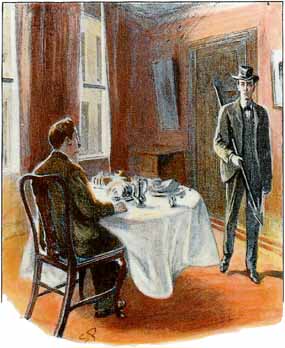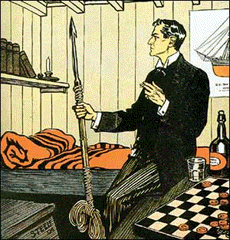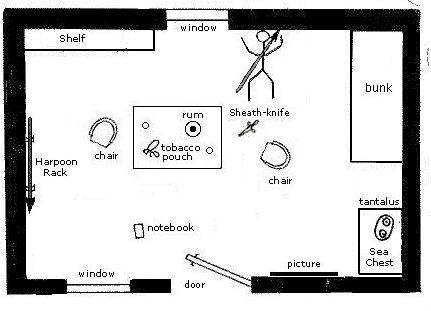The Case Against Patrick Cairns
As Inspector Hopkins remarked, "you would go far before you found a more dangerous man than Peter Carey". While captain of the steam sealer Sea Unicorn, he was known as Black Peter, in part due to his violent temper, especially when intoxicated. After settling at Woodman's Lee with his family, and even at age 50, his black violent moods continued. He had driven his wife and daughter out of doors in the middle of the night, flogging them through the park until the whole village outside the gates was aroused by their screams. On one occasion he was charged for a savage assault upon the old vicar.
Following Patric Cairns' apprehension at 221B Baker St., he asserted that the harpooning of Peter Carey was an act of self-defense. "I knew Black Peter, and when he pulled out his knife I whipped a harpoon through him sharp, for I knew that it was him or me. That's how he died." Later, when questioned, Cairns elaborated, "The first night he was reasonable enough, and was ready to give me what would make me free of the sea for life. We were to fix it all two nights later. When I came, I found him three parts drunk and in a vile temper. We sat down and we drank and we yarned about old times, but the more he drank the less I liked the look on his face. I spotted that harpoon upon the wall, and I thought I might need it before I was through. Then at last he broke out at me, spitting and cursing, with murder in his eyes and a great clasp-knife in his hand. He had not time to get it from the sheath before I had the harpoon through him. Heavens! what a yell he gave! and his face gets between me and my sleep."
 | If Cairns' account is true, that fatal encounter must have taken only 3 or 4 seconds. Even assuming that Peter Carey was intoxicated, his violent charge while unsheathing his knife could not have taken longer. In order to respond to Black Peter's attack before the latter had removed his knife from the sheath, Cairns must have been seated in close proximity to the harpoon rack, and acted with extraordinary speed. Although the size of the harpoon is not specified, illustrations by Sidney Paget and Frederic Steele suggest a length of 5 to 6 feet. A typical example is shown at Pelican Bay Nautical Gifts. Handling such an unwieldy weapon in haste would certainly require exceptional skill, and Cairns was an experienced harpooner.
|  |
| Sidney Paget | | Frederic Steele |
|---|
Unfortunately, our knowledge concerning the layout of the cabin's furnishings is sketchy. Indeed, we do not know against which wall the victim was skewered. One useful resource in this respect is Crime Scene Sketches by Thomas F. Hanratty. Two plausible floor plans, modified from Hanratty's drawing to represent the 10' x 16' cabin, are shown below. Others are clearly possible, but these are adequate for this discussion. One necessary feature present in both plans is the proximity of one chair, presumably that occupied by Patrick Cairns, to the harpoon rack. Without other information, known at the time of the inquest but not specified, further speculation about the arrangement of objects in the cabin is unwarranted. It should be noted, however, that Peter Carey's skewered body would have been seen more easily from the door in Plan B. Also, if Cairns were seated in the same chair (Plan B) during his first visit on Monday, his silhouette would have been visible from the road on the front window blind.
 | |  |
|---|
| Plan A | | Plan B |
|---|
The orientation of the cabin relative to the main house and the road is not well defined. As Holmes, Watson and Hopkins approached Woodman's Lee they saw it as a "long low stone house" on the green slope of a hill. "Nearer the road, and surrounded on three sides by bushes, was a small outhouse, one window and the door facing in our direction." This window would be the one on which Slater saw a silhouette early Monday morning, while passing on the high road. On the other hand, a path had been worn across the field by Black Peter as he walked daily from the house to the cabin, suggesting the door of the cabin faced the house and could easily be observed by one of the maids early Wednesday morning. Both placements cannot be true and the former is used for this analysis.
If we accept Patrick Cairns testimony, he hurled the harpoon while Peter Carey was charging at him, drawing his knife from its sheath. At that instant Carey must have been near the center of the room, rather than against a wall. Thrown with skill and strength the harpoon might well have transfixed Carey, but it could not have carried his body across the room impaling itself in the wall. Faced with this implausible outcome, we should follow Holmes' advice, "One should always look for a possible alternative, and provide against it. It is the first rule of criminal investigation."
Remembering that Cairns had met two days earlier with Carey, had been told about the value of the tin box and was familiar with the furnishings of the cabin, a different scenario presents itself. In the second meeting Carey may have changed his mind about sharing the wealth. Noting Carey's druken state, Cairns may have taken a harpoon from the rack to threaten him. Carey would have backed away from Cairns, reaching for his knife, until his back was against the wall. A hard thrust of the harpoon would then impale Carey to the wall, leaving the dropped knife at his feet. In the terms used by Holmes at the conclusion of the story, this account seems to "cover every point" without a significant "drawback".
Submitted by The Chemist



